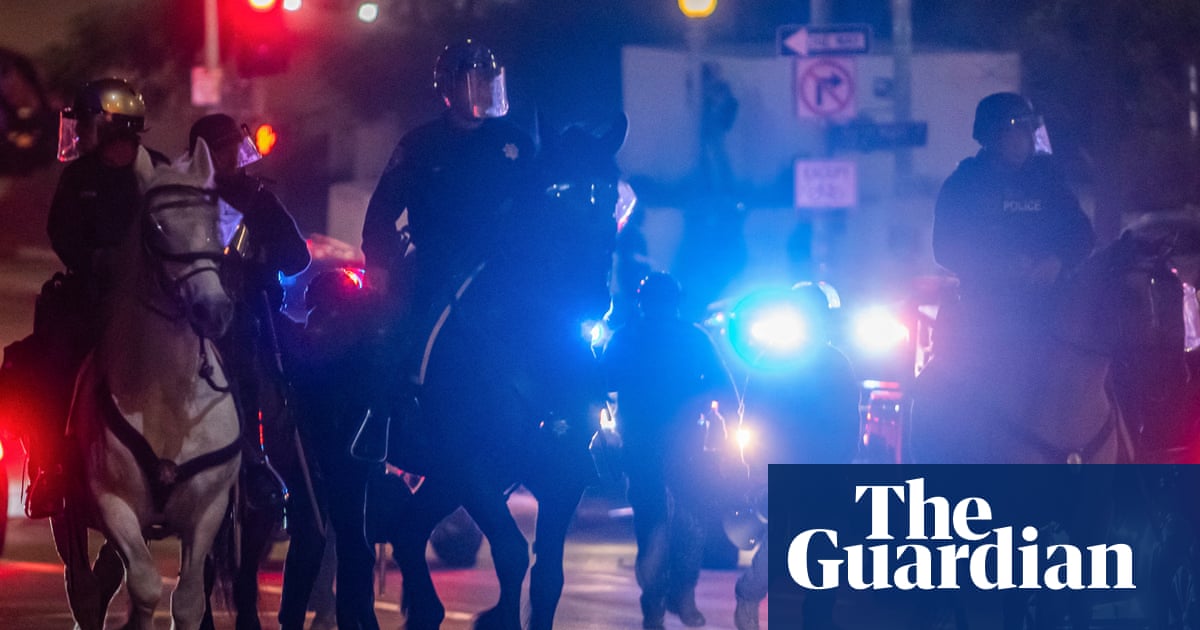Los Angeles police have announced they are making mass arrests in the city’s downtown area, as people gathered in defiance of an overnight curfew imposed after days of protests against Donald Trump’s immigration crackdown and military deployment.
Late on Tuesday night local time, the LAPD wrote on X that “multiple groups” continued to congregate within the designated downtown curfew area. “Those groups are being addressed and mass arrests are being initiated,” it said.
The mayor, Karen Bass, had announced a 10-hour curfew for a 1 square mile area of downtown, where demonstrations against Immigration and Customs Enforcement (Ice) have continued. The curfew was to run from 8pm to 6am, Bass said.
The LAPD said it had carried out more than 300 arrests of protesters in the last two days.
The crackdown came after California’s governor, Gavin Newsom, filed an emergency request to block theTrump administrationfrom using military forces to accompany Ice officers on raids throughout LA.
Trump has ordered the deployment of 4,000 national guard members and 700 marines to LA after days of protests driven by anger over aggressive Ice raids that have targeted garment workers, day labourers, car washes and immigrant communities.
Marines and the National Guard have no powers of arrest and are there to protect federal buildings.
Newsom and the California attorney general, Rob Bonta, alleged in alawsuitfiled on Monday that Trump’s takeover of the state national guard, against the governor’s wishes, was unlawful. On Tuesday a federal judge declined to immediately rule on California’s request for a restraining order and scheduled a hearing for Thursday.
In a speech, Newsom condemned Trump for “indiscriminately targeting hard-working immigrant families” and militarising the streets of LA, recounting how in recent days Ice agents had grabbed people outside a Home Depot, detained anine-months-pregnant US citizen, sent unmarked cars to schools and arrested gardeners and seamstresses.
“That’s just weakness masquerading as strength,” the governor said. “If some of us can be snatched off the streets without a warrant based only on suspicion or skin colour, then none of us are safe. Authoritarian regimes begin by targeting people who are least able to defend themselves. But they do not stop there.”
Newsom warned that Trump would not stop atCaliforniaand encouraged people to stand up to the president. “What Donald Trump wants most is your fealty, your silence, to be complicit in this moment. Do not give in to him,” he said.
Trump, meanwhile, delivered a deeply partisan military speech earlier on Tuesday, calling the LA protesters “animals” and vowing to “liberate Los Angeles”.
Speaking at a event in Fort Bragg, North Carolina, to recognise the 250th anniversary of the US army, Trump made thebaseless claimthat the demonstrations were being led by paid “rioters bearing foreign flags with the aim of continuing a foreign invasion”. Trump also repeated a viral conspiracy theory that pallets of bricks were left out for protesters to hurl at police officers.
On Tuesday night, hundreds of troops were transferred to LA over the objections of Democratic officials and despite concerns from local law enforcement
Pete Hegseth, the US defence secretary, said he expected the military would remain in the city for 60 days at a cost of at least $134m.
Trump said troops would remain until there was “no danger” and said he would consider invoking the Insurrection Act.“If there’s an insurrection, I would certainly invoke it. We’ll see,” he told reporters in the Oval Office.
Sign up toFirst Thing
Our US morning briefing breaks down the key stories of the day, telling you what’s happening and why it matters
after newsletter promotion
California’s lawsuit said: “Trump and Secretary of Defence Hegseth have sought to bring military personnel and a ‘warrior culture’ to the streets of cities and towns where Americans work, go to school and raise their families. Now they have turned their sights on California, with devastating consequences.”
The deployment of the national guard is strongly opposed by California Democrats, as well as by every Democratic governor in the US. Alex Padilla, the California senator, told the Associated Press on Tuesday that protests against Ice and the subsequent legal showdown between his state and the government was “absolutely a crisis of Trump’s own making”.
He said: “There are a lot of people who are passionate about speaking up for fundamental rights and respecting due process, but the deployment of national guard only serves to escalate tensions and the situation. It’s exactly what Donald Trump wanted to do.”
Padilla said the Los Angeles sheriff’s department had not been advised of the federalisation of the national guard. He said his office had pressed the Pentagon for a justification, and “as far as we’re told, the Department of Defence isn’t sure what the mission is here”.
Jim McDonnell, the LA police chief, said on Monday that the department and its local partners had decades of experience responding to large-scale demonstrations and that they were confident in their ability to continue doing so.
“The arrival of federal military forces in Los Angeles, absent clear coordination, presents a significant logistical and operational challenge for those of us charged with safeguarding this city,” he said.
The US Northern Command, or Northcom,said in a statementon Monday that marines from the Second Battalion, 7th Marines, 1st Marine Division “will seamlessly integrate” with forces “who are protecting federal personnel and federal property in the greater Los Angeles area”.
Northcom said the forces had been trained in de-escalation, crowd control and standing rules for the use of force, and that approximately 1,700 soldiers from the 79th Infantry Brigade Combat Team, a California national guard unit, were already in the greater Los Angeles area.
Robert Mackey and agencies contributed to this report
